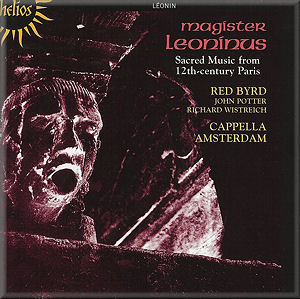子夜讀書心筆
寫日記的另一層妙用,就是一天辛苦下來,夜深人靜,借境調心,景與心會。有了這種時時靜悟的簡靜心態, 才有了對生活的敬重。50位西方偉大的作曲家(2)- Léonin 雷恩藍 ( c1150 - 1201,法國)


Léonin - Viderunt omnes (1)
Why is great: He was the first great exponent of "organum "
What's his story: One of the most importnt revolution in music was the creation of organum; for the first time in manu form, two or more lines of music moved together at the same time. In his Magnus liber, Léonin effectively spelt out the basic principles on which early polyphneic music was based. Much of his work consists of a slow - moving lower part supporting a decorative upper line.
Defining works: Non vos relinquam orphanos, Inter natos mulierum
(classic fm)
Leonin, 法國人,著名作曲家,(教會)管理人員, 詩人, 是polyphonic organum 的首創者,身居巴黎聖母院Notre Dame de Paris, 大概是polyphony 的Notre Dame 學校的最早期的, 主要成員。 關於他的記載是一個世紀以後世人在一位英國修道士的記錄的文字中發現:這位英國修道士在大教堂以著名匿名IV 提及Leonin, "大的書" organum 的理論。Leonin 大概並且是第一作曲家利用節奏性方式, 和並且可能發明一個記法,根據W.G. Waite, 在1954 年寫: "這是Leonin 的不能比較的成就第一次介紹節奏一個合理的係統入polyphonic 音樂, 和, 相等地重要, 創造記法方法傳神這節奏。"
Magnus Liber 意欲至於禮拜儀式的使用。這位修道士寫道:"Leonin was the best composer of organum for the amplification f divine service"根據匿名IV, "Magister Leoninus (Leonin) 是organum 的最好的作曲家; 他寫了大的書(Magnus Liber) 為逐漸和antiphoner 為神聖的服務。" 所有Magnus Liber 是為二聲音, 根據匿名IV, Leonin 的工作由後來的法國作曲家Perotin 改進了和大大地擴展了。
(文字來自DK Classical Music 和http://tieba.baidu.com/f?kz=10827273)
Léonin (active ca. 1165-1185), or Leoninus, of the Cathedral of Notre Dame in Paris, is the earliest known composer of polyphonic art music and the creator of controlled rhythm and meter, as well as of the earliest notation to convey rhythm.
About the life of Léonin absolutely nothing is known. His name is mentioned in a treatise, actually class notes taken at lectures an anonymous English student attended at the University of Paris about a century later, in the 1270s. In this treatise Léonin is connected with Paris and is praised as the best composer of organa (two-voiced settings of soloistic portions of chants of the Mass and the daily prayer hours).
Léonin evidently composed his organa for the Cathedral of Notre Dame, whose present magnificent stone structure rose in the main between 1163 and 1208. It has been suggested that he was a choirboy first and later became the master of the choirboys. This would account for the diminutive of Léo by which he was known and also for the absence of his name from the preserved list of the higher officers of the Cathedral.
Léonin's works may be called the cradle of Western art music. His organa are arranged for two vocal lines. One is the chant tune, the cantus firmus, laid out either in notes of undefined length or, in some sections, in a sequence of definite note values; the other is a newly composed melodic descant, a rhythmically controlled coloratura of great ingenuity, coordinated with the cantus firmus. Although organa had existed for some time before Léonin, the separation of these two styles, the "pure organum" - with long chant notes - and what was then called "discant," where both voices have strict rhythm, was his creation. So was the notation he used to symbolize this rhythm, the "modal notation," which laid the basis for musical notation as we know it. Moreover, his works constitute the first comprehensive repertoire of liturgical polyphony, which, with settings for about 100 Gregorian chants for all the major feasts of the Church year, remained in use for more than 2 centuries and spread to all the Western countries. This repertoire formed what the anonymous English student called the Magnus liber organi (Great Book of Organa); it became a widely imitated model.
The musicologist Craig Wright believes that Léonin may have been the same person as a contemporaneous Parisian poet, Leonius , after whom Leonine verse may have been named. This would make Léonin's use of meter even more significant.
answer.com




